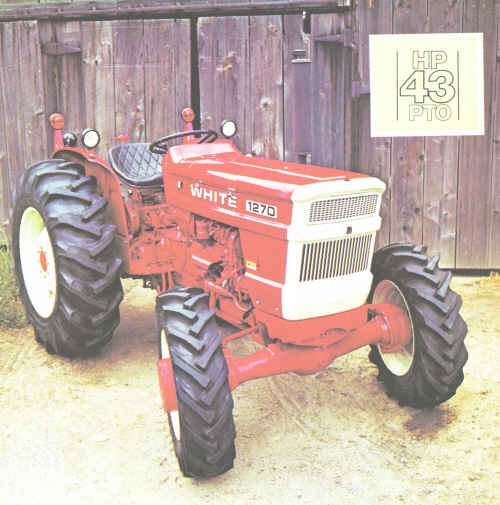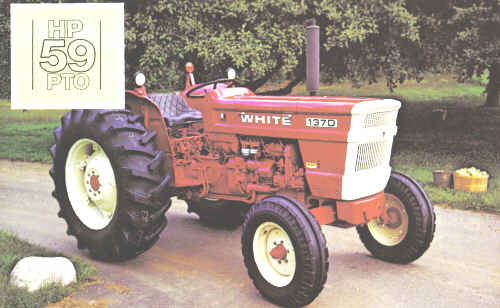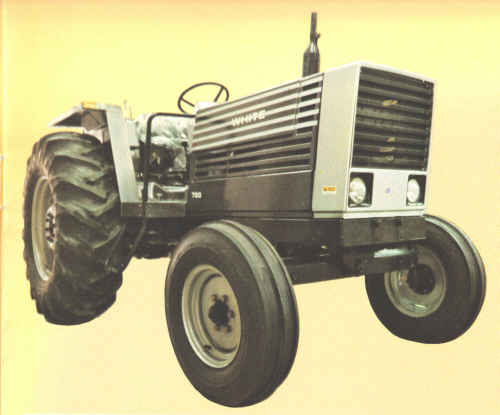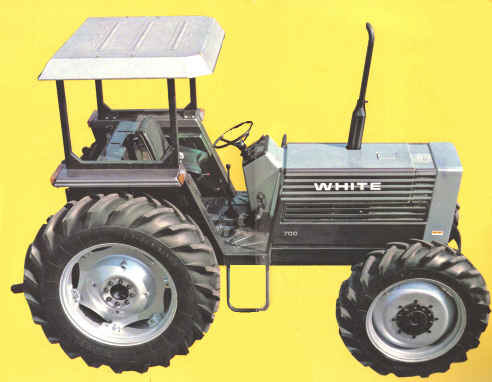The Fiat-Built Whites

The White 1270
From 1973 to 1976, the Cockshutt 1265 was also available as the White 1270, differing only in the decals.

The White 1370
Corresponding with the Cockshutt 1365, and (like the 1265/1270) only differing in the decals, the White 1370 was built from 1973 until 1975.

The White 1470
The Cockshutt 1465's White counterpart was the 1470, built from 1972 up 'til 1976, when all Cockshutt production was ceased. While this picture may not prove anything about the 1465 FWA, it does at least put the myth to rest that there were no White 1470 FWA tractors built, and adds credence to the fact that there were indeed Cockshutt 1465 FWA models.
A New Beginning... well... sort of...
Well, while 1976 brought the Olympics to Montreal, and the fantastic CN Tower to Toronto, it also rung a death knell in the Heartland of the Great White North: the end of the Cockshutt name on new farm equipment and tractors. White had slowly fazed their name in, and the Cockshutt name out. The 12xx 13xx and 14xx model prefix ceased production, as did the entire line of 55, 65, and 70 Series of tractors. While the beautiful Sumac Red paint would remain on implements and combines, it was replaced by silver and charcoal on the tractors.

The White 2-50 Field Boss
Stepping into the sweet little 1265/1270's place came the restyled White 2-50 Field Boss. It corresponded with the Fiat 540. Gone was the 6 speed forward, 2 speed reverse transmission with live PTO of the previous 3 cylinder Fiat tractors; the 2-50 was updated to the narrower ratio 8 speed forward, 2 speed reverse, independent PTO transmission of the 1365/1370 tractors. Included was a new grille, four poster ROPS and canopy, and new paint and decals. its engine pushed out a responsive 47 PTO horsepower at 2400 RPM.

The White 2-60 Field Boss
The White 2-60 Field Boss replaced the 1365/1370 tractors. Other than the new paint, style of grille--updated to include the then-trendy, modern rectangular headlights--and a four post ROPS equipped with a canopy, this was still a very familiar design to Cockshutt and White utility tractor owners.
Ok, now for something a little different...

The White 700 Utility
Beginning in 1977, to replace the discontinued 1465/1470 tractors, White began importing the Fiat 780 and 780DT, the "DT" standing for "Dual Traction", or, simply put: four wheel drive. Like the 1465/1470 tractors, the new White 700 was rated at 70 PTO HP, but using a more modern, more fuel efficient, and peppier, 4 cylinder engine of 223 cubic inches running at 2500RPM, compared to the 1465/70 series tractor's larger, slower 268 cu. in., 2100RPM unit.
Possessing a streamlined, squared-off appearance, the 700 didn't share the "Field Boss" nonclamature of its smaller 2-50 & 2-60 stablemates, but was called the 700 Utility instead. its engine was more along the lines of the 1365 than the 1465, and featured a crankshaft balancer. The transmission, also was more like a 1370 than a 1470, having 8 speeds forward, 2 speeds reverse, and an independent PTO. The new, shorter chassis and wheelbase design, and a tighter turning front axle, allowed the 700 to be a markedly more nimble, maneuverable tractor than the 1470, becoming again more like a 1370 in that regard. The higher operator's position made visibility better than all the prior Fiat-built tractors for loader and field work, and kept the operator cooler, also.
The 700 FWA model eliminated the need for universal joints and a telescoping section in the driveshaft with its true centerline design. A smaller differential and housing provided additional ground clearance, also aided by the streamlined, fully shielded driveshaft, which was additionally supported by a hanger bearing at mid-ships along its length. The driveshaft was mounted snugly up underneath the engine, and the full length shield ended wrapping of foreign matter around the shaft, and the damaging effect that would have on seals. The front axle itself was supported by a very rugged cast iron support member itself bolted to the front of the engine.

The White 700 Utility
Differing from both the 1365 and 1465 were the inboard planetary final drives, and the high, wide, open platform, rubber-isolated operator's station. The PTO lever was relocated to a more ergonomic rear right side floor position, and the parking brake (along with the FWA engagement lever on FWA models) was now situated opposite on the left side. The 700 also had many other updated features for easier operation, such as full hydrostatic power steering, hydrostatic power brakes, suspended pedals, left-or-right hand throttle, and the re-location of the fuel tank to the rear between the large, flat top fenders. The 700's quickly removable full engine side panels exposed the entire engine compartment in seconds for servicing. A four post ROPS with canopy and a seat belt were optional equipment. White didn't offer a cab for the 700, even though Fiat did have a cab for the 780 model. Speaking of the 780 model, Hesston 780 tractors are almost the exact same as White 700 tractors, differing only in paint and decals. Hesston did make the Fiat cab optional for their 780 model.
In a rather odd move, White didn't take advantage of the fact that the Fiat 780 had a full line of similarly-styled and equipped stablemates, from the 50HP Fiat 580, numerically right on up to the 180 HP 1880. While White's omission of the larger tractors in the Fiat line is obvious due to White's own domestic production of large tractors, the 580, 680, and 880-5 (there was a briefly-built earlier 4 cylinder Fiat 880, but the 880-5--a 5 cylinder--was the 780's contemporary) would have fit in very well with the 780/700. There could have been White 500, 600, 700, and 800 Utilities if White had chosen to make it so!
Thereby ending a long and successful relationship, the 700 Utility was White's last collaboration with Fiat of Italy, and White then turned to Iseki of Japan for production of its utility tractors.
Fiat-built Cockshutts

Parts for Fiat-built White Tractors







